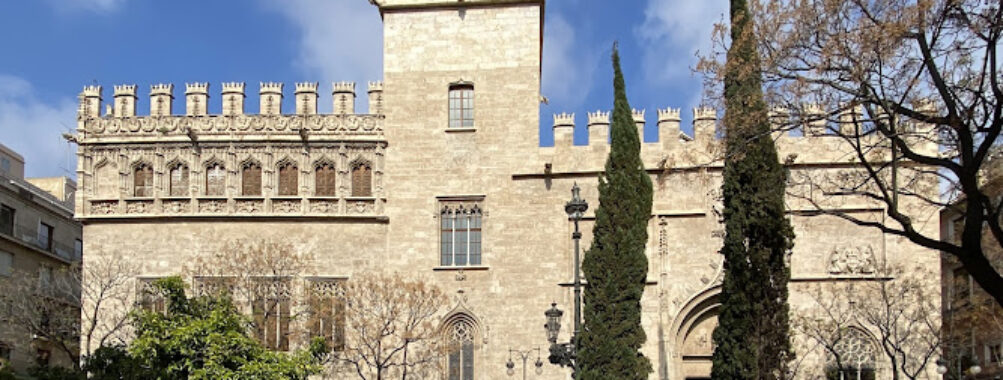
La Lonja de la Seda de Valencia
Table of Contents
Description
La Lonja de la Seda de Valencia, also known as the Silk Exchange, is one of those places that makes you stop in your tracks the moment you see it. Built between the late 15th and early 16th centuries, this UNESCO World Heritage Site is a shining example of late Gothic architecture, and honestly, it’s hard not to be impressed by the sheer ambition of it. The building was originally created as a hub for silk trading, which was booming in Valencia at the time, and it still carries that aura of wealth and prestige. The stonework is jaw-dropping, with intricate carvings that seem to whisper stories from centuries ago. And if you’re the kind of person who likes to just stand and stare at ceilings, the main hall will keep you busy for a while with its soaring, palm-tree-like columns.
Now, not everyone falls head over heels for La Lonja. Some visitors find it a bit underwhelming if they were expecting a museum packed with artifacts or interactive displays. But that’s not really what this place is about. It’s about atmosphere, history, and the feeling of stepping into a space that has witnessed centuries of trade, negotiation, and human ambition. Personally, I think that’s what makes it so special—you can almost hear the echoes of merchants haggling if you let your imagination run wild. Families, history buffs, and architecture lovers generally leave with glowing impressions, while some casual passersby might shrug and move on. Fair enough, but for those who appreciate craftsmanship and history, it’s a gem.
Key Features
- The grandiose Sala de Contratación (Contract Hall) with its twisted columns and high vaulted ceiling
- Elaborate stone carvings and gargoyles that reveal both religious and playful themes
- The Consulado del Mar, once used for maritime trade disputes
- A peaceful orange tree courtyard that offers a quiet break from the city buzz
- Wheelchair accessible entrance and restrooms, making it inclusive for all travelers
- Audio guides available for deeper storytelling and context
- Family-friendly environment that kids can enjoy without it feeling too stuffy
Best Time to Visit
If you’re like me, you probably don’t enjoy squeezing through crowds when you’re trying to admire centuries-old architecture. The best time to visit La Lonja is in the morning, right after it opens. The light streaming through the Gothic windows is softer, the halls are quieter, and you can really take your time. Weekdays are generally calmer than weekends, especially outside of peak tourist seasons like summer. Spring and autumn are sweet spots—not too hot, not too cold, and the city has this lively but not overwhelming energy. Visiting in the late afternoon can also be magical, but it tends to get busier as people finish their day and wander into the old town.
If you’re into photography, morning or late afternoon light will give you the best shots, especially in the courtyard. And during certain cultural events or festivals, the building sometimes hosts special exhibits or performances, which can add an extra layer to your visit. Just be prepared for larger crowds during those times.
How to Get There
La Lonja de la Seda sits right in the historic heart of Valencia, so getting there is pretty straightforward. If you’re already exploring the old town, chances are you’ll stumble across it while wandering the narrow streets. For those coming from further out, public transportation is your friend. Several bus routes stop nearby, and the closest metro stations are within walking distance. If you enjoy walking, the building is only a short stroll from other major landmarks like the Central Market.
Driving into the old town isn’t really the best idea unless you’re comfortable with tight streets and limited parking. Honestly, I’d recommend skipping the car altogether and opting for public transport, a bike, or just your own two feet. Valencia is a very walkable city, and half the fun is discovering hidden corners along the way.
Tips for Visiting
First thing’s first: give yourself time. Even though you might think it’s just a quick stop, the details are what make La Lonja unforgettable. The carvings, the ceilings, the little surprises tucked into the stonework—they all deserve more than a rushed glance. If you’re traveling with kids, the courtyard is a great spot for them to stretch their legs while you soak in the atmosphere.
I’d also recommend grabbing the audio guide. Without it, you might miss out on quirky details, like the symbolism in the gargoyles or the stories behind the merchants who once crowded these halls. And if you’re someone who likes to avoid crowds, plan your visit early in the day. Comfortable shoes are a must—the stone floors are beautiful but not exactly forgiving if you’re standing around for a while.
Accessibility is solid here, with ramps and restrooms designed to welcome all visitors, so if mobility is a concern, you’ll still be able to enjoy the site without hassle. And don’t forget your camera. Even if you’re not a big photographer, the play of light and shadow inside the main hall is just too good not to capture.
Lastly, keep your expectations aligned. This isn’t a museum packed with exhibits; it’s an architectural and historical experience. If you go in ready to appreciate craftsmanship and atmosphere, you’ll walk away with a deeper appreciation for Valencia’s past—and maybe even a new favorite spot in the city.
Location
Places to Stay Near La Lonja de la Seda de Valencia
Find and Book a Tour
Explore More Travel Guides
No reviews found! Be the first to review!